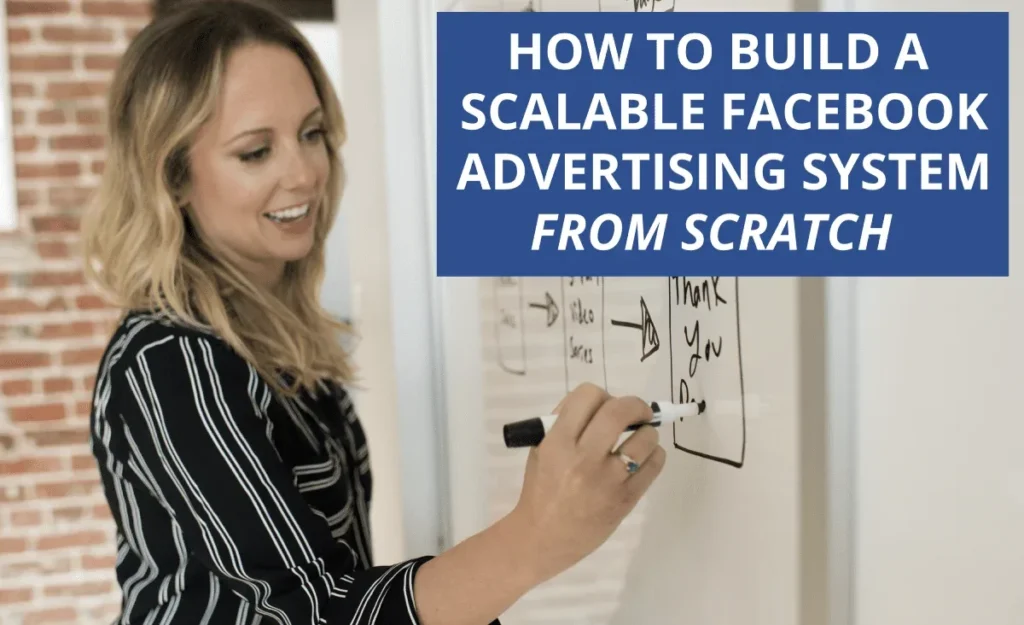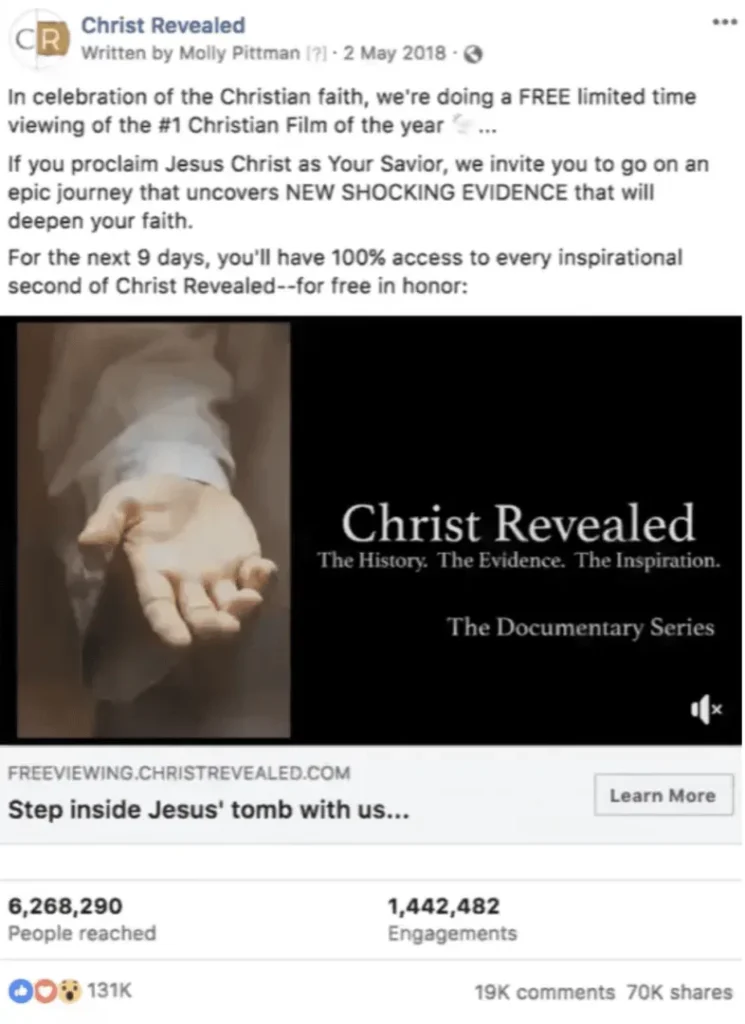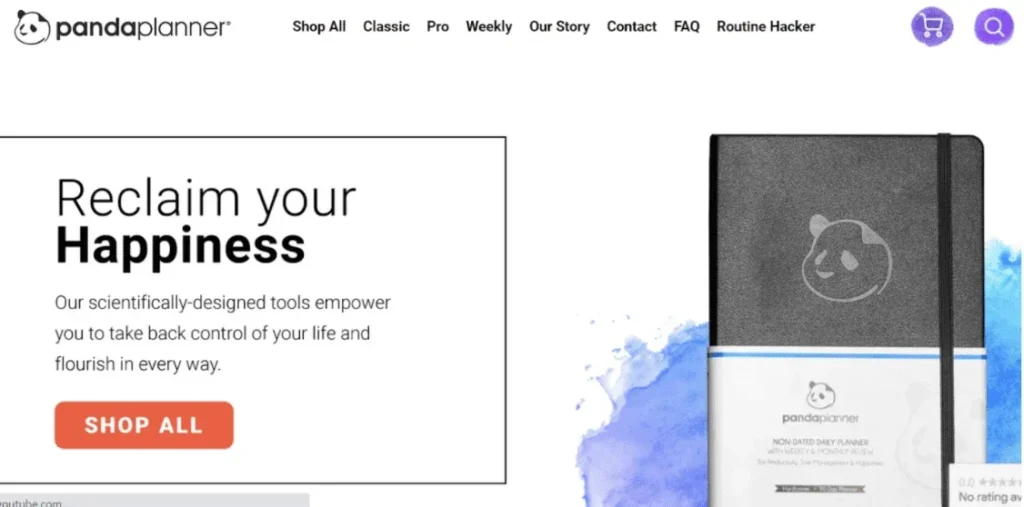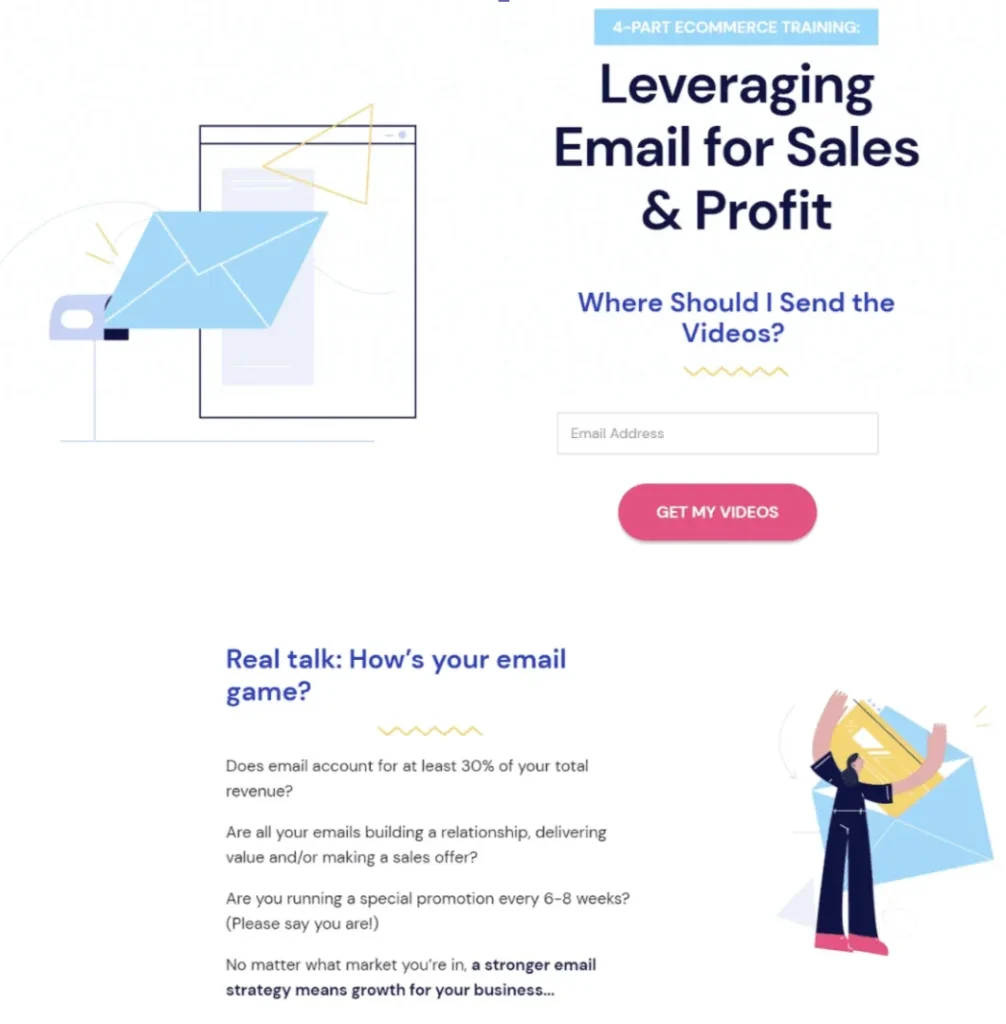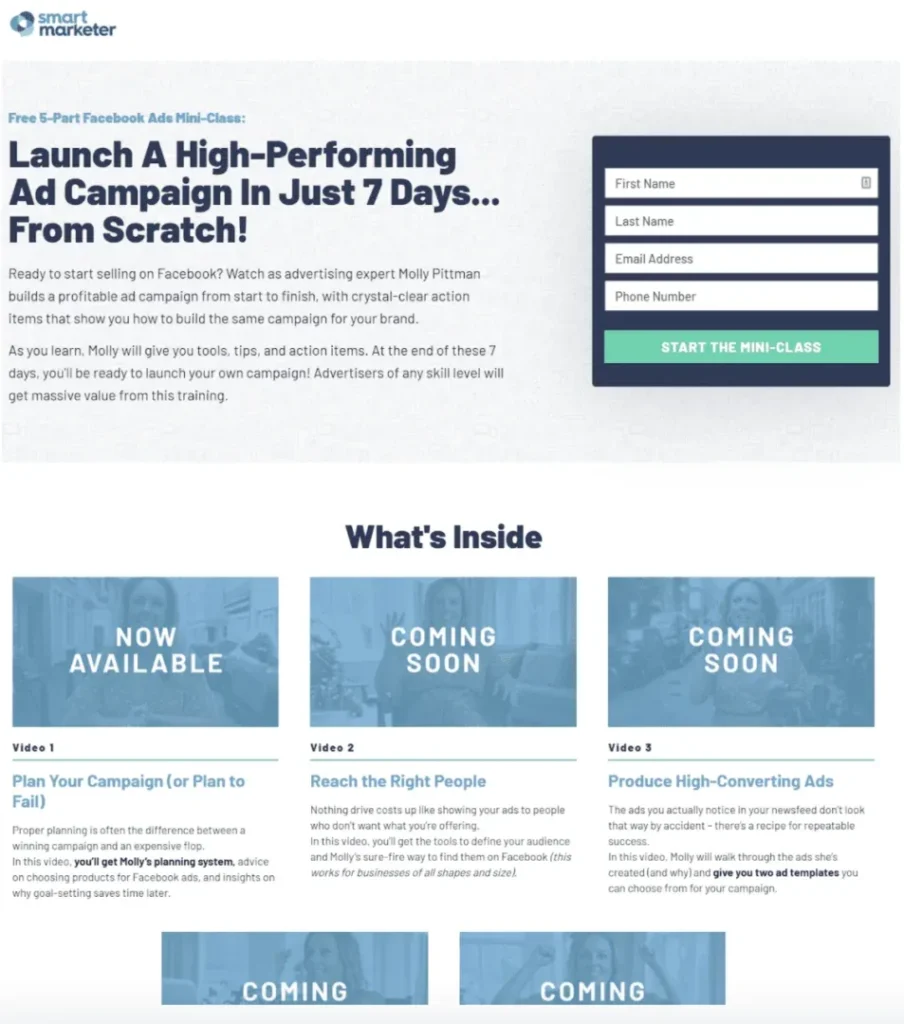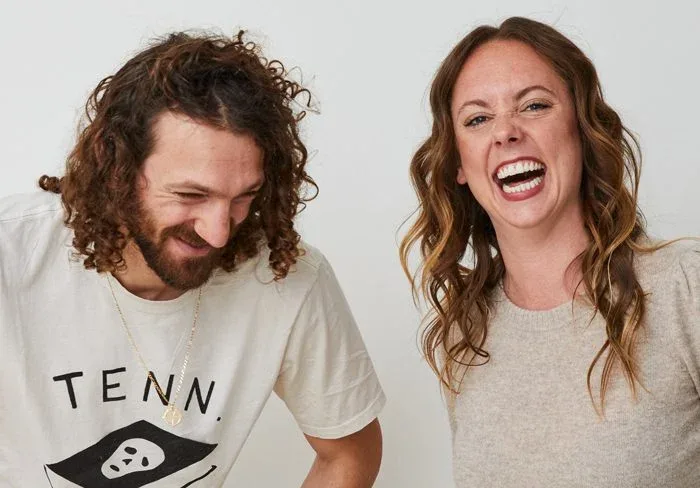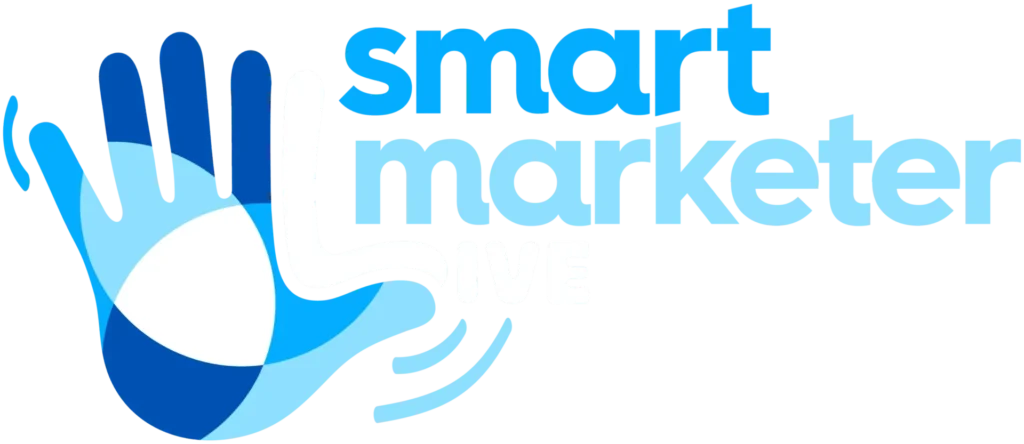What would I do if I had to start over and build a Facebook advertising system from scratch?
I recently got the chance to find out.
A few months ago, our Facebook account got shut down. A month after that, our account got hacked (and shut down again). Having to start over with a new account sucks—it’s a lot of work and there’s a big opportunity cost from not being able to run your already-optimized ads.
But if there’s a single lining, here it is: in starting over from scratch, we had the opportunity to be really intentional about how we created this traffic system – that’s what I call a comprehensive Facebook advertising strategy. So I didn’t just re-create the exact same campaigns we were running before. Instead, I spent a lot of time thinking about the best way to make sure this new account would provide a solid foundation for a profitable Facebook advertising system we could really scale.
And in this article I’ll share exactly what we did and why. I think this information will help you if you’re just starting out, starting over, wanting to rethink your whole strategy, or if you just want to learn more about media buying in general from our overall approach to traffic generation.
But before we get into the nuts and bolts, let’s talk about some considerations to keep in mind that will affect how you structure your Facebook advertising strategy.
Every Account Is Different
It’s important to realize that every Facebook account is different—because every business is different. Some businesses only need 2-3 campaigns, while others may need 12-15 or more. Here are the 3 biggest factors that affect campaign complexity:
Market-Centric vs Product-Centric Businesses
In my experience, businesses fit into one of two buckets: they can be market-centric, or product-centric.
Market-centric businesses are those that serve one particular market. For instance, this company is a market-centric business—they serve Christians:
Product-centric businesses are based around a product, rather than a market. An example of a product-centric business is Panda Planner:
See the difference? The market-centric business clearly serves one specific group of people. By definition, they have one avatar—which means they typically don’t need as many campaigns.
The product-centric business, on the other hand, has a product that can potentially appeal to many different groups of people…which means a product-centric business usually needs several campaigns to target their 3-5 avatars.
Local Businesses
If you’re a local business, your reach is limited by the local population. As a result, your Facebook advertising system will need to be fairly simple:
- 1 acquisition campaign (to get them in the door)
- 1 conversion campaign (to get them to buy)
- 1 retargeting campaign (to get them to come back)
Traffic Levels
Generally speaking, the more traffic you get, the more complex your Facebook ads setup needs to be. Take BOOM! for example. BOOM! will sometimes spend upwards of $25k in a single day!
As a result of all that scale, BOOM! gets a lot of traffic—which means we’re able to get really specific with our avatars and our retargeting. We can retarget people who visit our presell pages but don’t click through to the product page, people who visit the product page but don’t add to cart, people who add to cart but don’t buy, and so on—whereas a business with less traffic may need to combine all those audiences in order to have a big enough audience to target. (We call that squishin’ ?.)
The take-home message is this: the more traffic you get, the more granular, segmented, and complex your Facebook advertising system usually needs to be.
Business Type
Another variable that will affect what kind of traffic campaigns you need is your business type:
- SaaS company
- Ecommerce store
- Info product business
- Consultant
- And so on
Different types of businesses have different sales processes, marketing funnels, lead-nurturing times, and so on. An ecommerce company like BOOM!, for instance, can sell the same product to the same person over and over again (refill orders). But that’s not the case for a SaaS company with a continuity product, which needs to focus more on generating new customers and reducing churn.
So as you’re building out your Facebook advertising system, realize that your business needs are unique and adjust accordingly.
Where Should You Put Your Focus?
When you’re building a brand-new Facebook advertising strategy from scratch, you can’t do it all at once. You have to prioritize what campaigns and traffic segments to focus on first.
Remember, we’re NOT just building a one-off campaign here. We’re building a complete Facebook advertising system—an assembly line that carries your prospects all the way through the Customer Journey from “unaware” to “ambassador.”
And with that in mind, you want to start by creating a traffic foundation that can scale as quickly, efficiently, and profitably as possible. With a brand-new Facebook advertising system, that means focusing on cold traffic to start.
Why should you start with cold traffic?
Well, think about it in terms of the classic marketing funnel. Cold traffic is the top of the funnel; it’s where new people enter your Facebook advertising system. You can’t do much in terms of retargeting yet, because your audiences are too small. That’s why your first order of business should be to get traffic flowing through that funnel by targeting cold traffic.
A business like BOOM! uses 8-10 retargeting campaigns, but the only reason that’s possible is because they get tens of thousands of visitors every day.
Over time, as your audiences grow, you’ll be able to segment and do more bottom-of-funnel marketing. But first you need to actually fill that funnel with people—by targeting and scaling your cold traffic.
Structure Your Campaigns for Horizontal Scale
Here’s another important concept you should understand when building a Facebook advertising system: the difference between vertical scale and horizontal scale.
Vertical scale is what most people think of when they think about scaling—increasing the budget to reach more people with your existing campaigns.
Horizontal scale is different. It’s when you expand your Facebook advertising with brand-new audiences, hooks, and offers that allow you to reach an entirely new type of customer.
Both are important and both are effective. At the end of the day, scaling horizontally is more difficult—it involves more work, more experimentation, more customer research, and more creative thinking. It also has more potential to grow your traffic and your business.
When you’re able to create new offers and ads that reach brand-new segments of the market, that’s where true customer acquisition scale comes from.
So what does that mean, practically speaking?
It means you need more than just one lead-gen campaign. It means you should always be testing out new ads and offers to reach people with different preferences and interests. And when you find a campaign structure that works, repeat it for different offers and avatars.
You’ll see how I took that approach in step 2 below.
And now that we’ve gotten the most important concepts out of the way, let’s go step-by-step through the creation of our brand-new Facebook advertising system. Starting with…
Facebook Advertising System Step 1: Promote Content
The first thing we did for our new ad account was to run a simple, small-budget page post engagement campaign for some blog posts. This is pure content marketing, which helps to boost your page’s engagement and begins to “season” your Facebook pixel (AKA teaching it about your audience).
Anytime you create and promote content, make sure it’s relevant to something you sell on the backend. This way you’ll know you’re actually attracting the right audience—an audience that will be interested in buying your product.
Facebook Advertising Step 2: Lead Generation
OK, so the content marketing is almost like a warm-up. It gets your account up and moving. But here in step 2 is where you’ll really start to move the needle for your business.
Remember that for a new Facebook ads strategy, your focus is going to be on cold traffic. And the name of the game for cold traffic is lead generation.
Generating leads allows you to provide prospective buyers with something of value, while building interest in your topic. It also grows an important business asset: your email list.
When we restarted our Facebook Ad Account, here’s how we prioritized our lead gen campaigns.
First, Start with What’s Already Working
If you’ve run a successful lead-gen campaign in the past, then by all means—start by running it again!
If you know a campaign will work, there’s no reason not to run it.
In our case for Smart Marketer, there were two campaigns that we had run effectively in the past. Both drove people to an opt-in page for a free video series.
One was about email marketing:
And the other was about project management:
When the visitor opted in, they would get the video class for free, and then we later upsold them on a relevant product (Smart Email Marketing & Smart Project Management).
We knew these campaigns would work, because they worked in the past. This made them a low-risk way to restart our lead generation.
Next, Apply What Works to a New Offer
Offering a free video series has always worked for us. Free mini-classes drive leads at a good cost per lead, and also warm up cold audiences and make them more receptive to purchasing higher-dollar programs.
Remember how I said to scale horizontally, you need to find a campaign structure that works…then do it again? Well, that’s exactly what we did here—by following the same funnel format with a new free video course on Facebook Ads.
Here’s the landing page for the free mini-class:
The product we promoted at the end was Train My Traffic Person.
We prioritized this as our next campaign because we had a lot of reasons to be confident that it would work:
- We knew offering a free video series worked
- We knew our audience was interested in Facebook Ads
- We know that Train My Traffic Person was our best-selling product
As expected, this new lead-gen campaign was also very effective.
Can you see why this is such a good approach? By tweaking what has already worked in the past, you’re reducing unknowns, lowering risk, and giving your new campaign a much higher likelihood of success.
But Don’t Be Afraid to Try Something New
Tweaking the same type of funnel is great. But it doesn’t always work—sometimes, depending on the nature of your offer, you may need to test a new type of funnel entirely.
This happened to us when we were promoting a new offer called the Ambassador Blueprint. This was a product Ezra created that teaches people how to build an Ambassador Program that helps them to get awesome user-generated content they can use in their ads.
Having seen the results of the Ambassador Program for BOOM! by Cindy Joseph, I knew that this training would be incredibly valuable for the right company if they implemented it. But I also could also see that it wasn’t a very sexy-sounding topic on the front end.
I didn’t think people would be interested in signing up for a free video class on Ambassador programs, because, well, most people don’t know what an Ambassador Program is. Let alone how it can help grow your bottom line.
(Email marketing and Facebook ads, by comparison, are well-known topics. People already understand why they’re important.)
So our challenge was: how do we position the front-end of a product that’s valuable, but not sexy?
Part of the problem came down to education. People needed to be taught why user-generated content is so effective, so they could realize the value of a training like Ambassador Blueprint. So we decided to create a brand-new front-end funnel that swapped out the free video series and replaced it with this presell article:
One big difference with the presell article, compared to the video series, is that the article doesn’t require people to opt in. Now, this means we don’t grow our list…but it also means we get the chance to appeal to new kinds of consumers—people who don’t like to consume video and people who don’t like to give out their email address.
The presell article also gives us a way to educate the visitor on what an ambassador program is and why it can help them.
So we ran the presell article, and it worked really well. So now, guess what we’re doing next?
That’s right—we’re doing it again with more offers! We’ve already got 3 more presell article funnels planned out for topics like Facebook targeting and email templates.
(Hint, hint: that’s more horizontal scaling at work.)
Keep Scaling Horizontally
Hopefully by now you get the idea. When you find something that works, do it again with a new offer or audience. This is how you create true scale in your company by reaching more and more of the market.
This should be a continuous process, guys! Just because “Lead Gen Campaigns” is step 2 in this Facebook advertising system doesn’t mean you can stop doing it once you move on to step 3.
Nope. Uh-uh. You should ALWAYS be running lead-gen campaigns, always trying to tap new segments of the market, always filling your funnel with more prospects to move through the Customer Journey.
My goal for Smart Marketer is to roll out one new lead gen campaign a month. It’s a great way to get a new product out there in a way that’s scalable and evergreen.
A Recap of Our Facebook Advertising System So Far
OK, let’s take a minute to take stock of where we’re at:
-
1) We started our Facebook advertising strategy by promoting content to increase our page engagement.
2) Then we re-launched 2 video series that were already working well.
3) Next, we tested another video series—one we were very confident was going to work.
4) Only then did we test a completely new acquisition funnel (presell article).
5) And now that we know presell articles work, we’re planning to roll out even more of them.
Even though this is a new account, it’s already humming along and generating a lot of new leads for us. We haven’t gotten to bottom-of-funnel stuff, like retargeting, yet—but that’s OK! We need to build up our audience size first.
That’s it for Part 1 of How to Build A Scalable Facebook Advertising System From Scratch. Below you can check out Part 2 (which we released a few weeks after Part 1 was published). In Part 2, you’ll learn how to build the rest of your brand-new Facebook advertising strategy.
How to Build a Scalable Facebook Advertising System From Scratch, Pt. 2
Let’s pick up where we left off by talking about the other side of the scaling equation. You can think about account growth like, well, a scale. We need to introduce the concept of vertical scaling.
Horizontal Scale Must Be Balanced With Vertical Scale
Yes, you want to be continually testing new lead-gen campaigns to reach new segments of your market. But at the same time, you also need to balance that with vertical scaling.
In other words: when you hit on a new offer, hook, or angle that works—scale it up!
Don’t let a desire to achieve horizontal scale prevent you from taking maximum advantage of what’s already working.
Horizontal and vertical scale are both important, and you need to keep them in balance. How you achieve that balance will depend on a couple factors, including how much support you have from other team members.
If you’re a solopreneur or don’t have a lot of support, you’ll have to prioritize what’s most important to make the most efficient use of your time. This might mean focusing on horizontal scale until you identify a winner, then focusing on vertical scale to maximize the return from it.
If you can leverage a team, on the other hand, you might want to have two different people responsible for your vertical and horizontal scaling efforts.
?? That’s what we’re doing right now at Smart Marketer. We hired a new Media Buyer who is responsible for working with the campaigns that are running right now. She provides our vertical scale.
And I’m working on building out new offers and assets to appeal to new audiences to provide the horizontal scale.
Step 3: Build Out More Front-End Offers
At this point we have a few lead-gen campaigns running, and we’re actively working on building out even more. Next up for us is to test an even wider variety of front-end offers to generate leads and attract even more people into our ecosystem.
Some of the offers in our pipeline include:
My New Book
I recently published a book called Click Happy: Your Guide to a Meaningful Life & Career in the Digital Era. We’re going to offer this as a front-end offer at a low price-point ($15-$17), which makes it a versatile offer we can use for both cold traffic and for retargeting other audiences.
Real books make a great front-end offer. People are familiar with books. We trust books. And we tend to associate them with a high level of quality.
There’s also a certain level of credibility that comes from being an author that can carry weight with people in your market.
PDF Lead Magnets
While PDFs may not carry as much perceived value as a physical book or a video series, I know from my experience at DigitalMarketer they can be fantastic assets that can really help to grow your reach.
In fact, some of our most significant growth at DigitalMarketer came as a result of having built out a diverse library of PDF lead magnets we could use to attract many different kinds of people interested in digital marketing.
For Smart Marketer, we plan to first test using some of our AdSumer Reports for this purpose. These are basically huge swipe files of all the ads in a particular industry, along with a detailed analysis of that industry and some of the biggest players in it.
It’s one of our deliverables for Team Traffic, and makes a lot of sense as a front-end offer.
If that works well (and I think it will), then we’ll certainly start going down the rabbit hole of creating more and more PDF assets we can use to attract new leads.
Launching a New Podcast
Last but not least, here’s some exciting news:
We’re planning to launch a Smart Marketer podcast!
It may not seem directly related to our traffic system, but it really is. Having a podcast gives you a ton of top-of-funnel content that you can run traffic to to generate awareness and build credibility with new prospects.
We’re also planning on trying to make an initial splash with a launch contest where the winner will get a “Marketing Makeover” with Ezra, John, and myself.
Then we’ll actually record the makeover and publish it to show our winner’s progress over time.
Here’s what I want you to notice: even though all these offers are quite a bit different (a book vs a podcast), we’re strategically choosing front-end assets that will attract the right kinds of people, and that will naturally lead to one or more of our back-end offers.
Step 4: Work on Your Back End
Finally, it’s time to work on our back end.
(And no, I don’t mean THAT back end. ?)
If the front end is where you target cold traffic, the back end is where you target and re-target your warm audiences: site visitors, page engagers, previous customers, and so on.
At this point in our traffic system for Smart Marketer, our audiences are still pretty small. So we’re keeping the back end simple and straightforward for now.
We’re retargeting people who hit our presell pages and don’t convert, and also visitors to our Blue Ribbon landing page who don’t convert (since that’s a high-dollar sale for us).
Otherwise, we’re not doing any other retargeting for specific offers—because, as I said, we don’t yet have the audience sizes to be able to do it. But we’re working on slowly building out those back-end campaigns as our traffic grows.
Eventually, we’ll get to the point where we have specific retargeting campaigns for each of our products. We’ll also start to think about smart ways to retarget people with relevant cross-sells.
But for now, we’re prioritizing our remarketing to focus on the lowest-hanging fruit first. That means the next 2 retargeting campaigns we create will be:
- Retargeting shopping cart abandoners
- Retargeting with Dynamic Product Ads
The DPAs, in particular, could work especially well for us since we’re on the Shopify platform.
Step 5: Leverage Other Traffic Platforms
So far, I’ve been referring to this as our “Facebook advertising system.” But we’re also working on branching out to other platforms. Namely, Google and YouTube.
At the moment, our Google and YouTube spend is limited to retargeting—with our cold traffic all being generated on Facebook. But we’re working with Tom Breeze to reposition what’s worked on Facebook for other traffic platforms.
Just like investors recommend diversifying your investment portfolio, as marketers and media buyers it’s also smart to diversity our traffic systems. Doing so can help reduce risk, increase traffic, and reach new segments of our market that maybe don’t hang out on Facebook or Instagram.
Recap & Takeaways from Our Facebook Advertising System
Our new Facebook advertising system isn’t complete. But we’ve come a long way in a short time, and we’ve got a clear path forward.
Let’s take a minute to take stock of everything we’ve done so far:
1. We started our Facebook advertising strategy by promoting content to increase our page engagement.
2. Then we re-launched 2 video series that were already working well.
3. Next, we tested another video series—one we were very confident was going to work.
4. Only then did we test a completely new acquisition funnel (presell article).
5. Now that we know presell articles work, we’re rolling out even more of them.
6. We’re also developing a wider variety of front-end offers, including a book funnel, PDF lead magnets, and a podcast.
7. Right now we’re only running basic retargeting, but we’re building that out as our traffic increases (starting with cart abandoners and DPAs).
8. We’re actively branching out and repositioning our content for other platforms like Google and YouTube.
So what are the big takeaways for you?
1) Take this process one step at a time.
You can only do so much at once, so don’t overwhelm yourself. Start where you’re at and take the next step. Just because we’re testing new front-end offers every month doesn’t mean you have to, especially if you don’t have the time or resources.
2) Start with the front end and scale horizontally.
The front end feeds the back end, so you have to start there first. We’re still focused mainly on cold traffic, and building out our back end gradually over time.
Always keep trying to reach new segments of the market by testing different offers, ads, and hooks.
3) Keep the big picture in mind.
It’s common for media buyers to get too granular and judge all their campaigns by the same criteria. But that’s a mistake.
Your campaigns all work together like the different assembly lines in a factory. Maybe one campaign’s job is to bring people into your business, then hand them off to another campaign that’s better at converting them into customers.
The point is, when evaluating your performance, you need to keep that bigger picture in mind. Think about how your campaigns work together. And choose the KPIs that make sense for each one.
Remember that your goal isn’t to have a successful campaign—it’s to have a successful business.
And when you can regularly add new campaigns that do their part in generating awareness from cold traffic then converting it into sales, you’ll be well on your way to having your own profitable, scalable Facebook advertising system.

